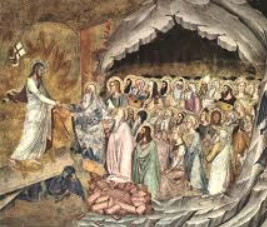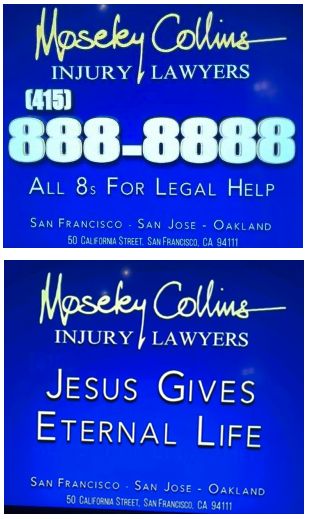Death, Resurrection, and the Road to Salvation

A pdf version of this commentary can be read and/or printed here.

Preface: On the Road Again
“Damn there’s a traffic jam,
How I hate to be late,
It hurts my motor to go so slow.
Damn this traffic jam,
Time I get home my supper’ll be cold,
Damn this traffic jam.”
Singer/songwriter, James Taylor 1977
Driving the maze of the Los Angeles freeway system recently I was, once again, reminded of the primary mode of mass transit in the LA basin; namely thousands and thousands of vehicles clogging every lane of every highway, day or night. And along every route, I could not help but notice nearly every billboard lining the road was the smiling face of an earthly savior or good Samaritan in the visage of an injury lawyer; ready to rescue those who could otherwise be discarded on the wayside of life.


As tacky and ludicrous as such an ad may seem to someone like myself, the underlying message of eternal life is an elusive promise that has seemingly been peddled in one form or another since the dawn of human history; along with the emergence of all sorts of religious beliefs and traditions.
The Christian faith tradition – in all its various interpretations and expressions — is no exception of course. In the case of one modern-day pharisee, named Moseley Collins, it is his particular ‘Jesus’ character who would promise any sojourner clear direction how to travel a road to salvation.
Because we have arrived at that point in the liturgical calendar of this religious tradition that observes the tales surrounding the death and proclaimed resurrection of the historical Jesus of Nazareth, it seems appropriate to at least pull into a rest area; to pause, reflect and consider where we’re going.
Myth and Metaphor: A Road (Sometimes) Less Traveled
“Now when I die
I don’t want no coffin,
I thought about it
All too often.
Just strap me in
Behind the wheel
And bury me with
My automobile.”
Singer/songwriter, James Taylor 1977
Each year in the Christian calendar there is the religious journey of Palm Sunday (otherwise known as the Sunday of the Passion), Holy Week and Easter. It begins with the comic tale of Jesus’ triumphal entry into Jerusalem on a jackass; making a mockery of the monarchical reign of merely-earthly kingdoms; while – in keeping with his life example ad teachings — suggesting a different vision.
Then he’s arrested, tried, convicted, executed, and buried. There is no eyewitness to an alleged “resurrection;” which is not to be so commonly misinterpreted as resuscitation. Rather, there is only an empty tomb, symbolizing the end of what was once, and is no more. It is a gentle reminder of the impermanence for these mere mortal lives of ours. [See “The Impermanence of All Things, and What Remains” here] Then to drive home the point, the gospel’s post-resurrection appearance stories are spun to suggest a new way of forever seeing the world around us.
This particular understanding of Jesus’ presence and role in our lives today is certainly different than the case which that injury attorney would promise; and, admittedly, a road less travelled. But to assert these gospel stories we know so well are essentially myths and metaphors is hardly to dismiss them as fairy tales for those who blindly want to believe they can live happily ever after, and literally forever. Quite the contrary.
Myths are universal tales that have been created, told and re-told from generation to generation, in both oral and written traditions; for as long as humans have striven to make sense out of the lives we live and discover what is true. And the metaphorical language employed is most often the way such stories are told and meant to be heard and interpreted as what is real; beyond what is merely factual. As a result, such mythic tales are just the opposite of a literal understanding of what often poses as reality.
Biblical scholar John Dominic Crossan has written about what he calls the “inevitability of metaphor” in a recent article, entitled, “Jesus at Easter: Individual Ascension or Universal Resurrection?” He writes,
“The English word metaphor comes from two Greek words “to carry over” or “across,” which means that the word metaphor is itself metaphorical … A metaphor carries some-thing from some-this to some-that. For example, ‘The clouds sail across the sky’ is a metaphor … We all recognize that process and do not expect to be corrected by literalists when we use such small metaphors. But when metaphors grow big enough we call that tradition and, if bigger still, we call it reality. Human reality is always derived from and created by seeing-as.”
To understand the application of Crossan’s point, with regards to our religious observances of Jesus death and resurrection in the Christian faith tradition, Crossan continues,
“In my understanding, Jesus’ Ascension or Resurrection are metaphors – but each a different seeing-as of Easter as an interpretation of Jesus’ execution and consummation of his vision. I do not consider either Ascension or Resurrection as literal events visible in time and place, but I still consider them to be real because when a metaphor – be it good or bad – is lived out it creates reality, and that reality is then tested across time and place for its ongoing vitality and long-term validity.
The opposite of metaphorical is literal, the opposite of real is unreal. We mut never regard the metaphorical and real as opposites because the metaphorical – if lived out – is the only human way to create reality, for better or worse in the long term.”
When all is said and done, what then are we to make of the mythic tale of Jesus’ death and resurrection, metaphorically told to convey what all of us might like to assert to be the “gospel truth?”
If there was just one word to be spoken — instead of what an old colleague of mine and poet-farmer used to refer to as “nothingness in many words” — it might best be described and left for the reader to discover in one of his most recent poems, entitled, “That One Word.”
Decide for yourself what that one (metaphorical) word might be. Then consider if that one, single, sufficient word might have once been uttered by the risen Lord of your life.
THAT ONE WORD ©
How many words will be spoken
Before one will raise us
Up when we are down?
That one word will not be “god”,
There being so many to whom we’d bow,
Some to tease only, in the end, to fail us,
Some intending even to slay us,
A babble towered to the heavens,
Topped, at last, and tongueless.
That one word will, likely, be uttered by eyes,
A gaze, beloving, into another’s, deep and present,
A tear welling, running down the cheek,
Anointing trembling flesh, the blush
Becoming the Word that will raise us
Up when we are down.
+John S. Thornton
© 2023 by John William Bennison, Rel.D. All rights reserved.
This article should only be used or reproduced with proper credit.
To read more commentaries by John Bennison from the perspective of a Christian progressive click on the Archives. http://wordsnways.com
